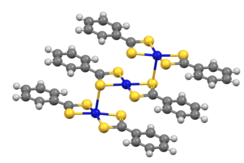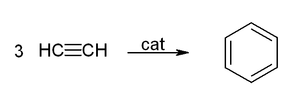Trimer (chemistry)
In
Examples
Alkyne trimerisation

In 1866, Marcellin Berthelot reported the first example of cyclotrimerization, the conversion of acetylene to benzene.[1] This process was commercialized:
Nitrile trimerization
Symmetrical
Cyanogen chloride and cyanogen bromide each trimerize at elevated temperatures over a carbon catalyst.[1] The chloride gives cyanuric chloride:
The bromide has an extended shelflife when refrigerated. Like the chloride, it undergoes ab exothermic trimerisation to form cyanuric bromide. This reaction is catalyzed by traces of bromine, metal salts, acids and bases.[2] For this reason, experimentalists avoid brownish samples.[3]
An industrial route to cyanuric acid entails the thermal decomposition of urea, with release of ammonia. The conversion commences at approximately 175 °C:[4]
The endothermic synthesis of melamine can be understood in two steps.
First, urea decomposes into
Then in the second step, cyanic acid polymerizes to form cyanuric acid, which condenses with the liberated ammonia from the first step to release melamine and water.
This water then reacts with cyanic acid present, which helps drive the trimerization reaction, generating carbon dioxide and ammonia.
In total, the second step is
but the overall process is
Diene trimerisation
The 1,5,9-trans-trans-cis isomer of
Breaking carbon-hetero double bonds forms symmetrical saturated 1,3,5-heterocycles
Cyclotrimerization of formaldehyde affords 1,3,5-Trioxane:
Three molecules of acetaldehyde condense to form paraldehyde, a cyclic trimer containing C-O single bonds.
Catalyzing and dehydrating by sulfuric acid, trimerization of acetone via aldol condensation affords mesitylene[7]
Trisiloxanes
Dimethylsilanediol dehydrates to a trimer of Me2SiO as well as
Coordination chemistry
The

See also
References
- ^ ISBN 3527306730.
- ISBN 9780470842898.
- ISBN 978-0471936237.
- ^ Klaus Huthmacher, Dieter Most "Cyanuric Acid and Cyanuric Chloride" Ullmann's Encyclopedia of Industrial Chemistry" 2005, Wiley-VCH, Weinheim. doi 10.1002/14356007.a08 191
- ISBN 3-527-28838-4
- ^ Bost, R. W.; Constable, E. W. "sym-Trithiane" Organic Syntheses, Collected Volume 2, p.610 (1943). "Archived copy" (PDF). Archived from the original (PDF) on 2012-03-29. Retrieved 2014-05-05.
{{cite web}}: CS1 maint: archived copy as title (link) - ^ Cumming, W. M. (1937). Systematic organic chemistry (3E). New York, USA: D. Van Nostrand Company. p. 57.
- .




![{\displaystyle {\ce {3 H2N-CO-NH2 -> [C(O)NH]3 + 3 NH3}}}](https://wikimedia.org/api/rest_v1/media/math/render/svg/6de156d81639cf3dcee9ba7233f13135ba2bfa91)


![{\displaystyle {\ce {3 HOCN -> [C(O)NH]3}}}](https://wikimedia.org/api/rest_v1/media/math/render/svg/e6a34f3b03c3ba201baf55fca465c07bf72526c7)
![{\displaystyle {\ce {[C(O)NH]3 + 3 NH3 -> C3H6N6 + 3 H2O}}}](https://wikimedia.org/api/rest_v1/media/math/render/svg/622a370fe2c00b97f4012e0e3294ddc0741bcc0f)



